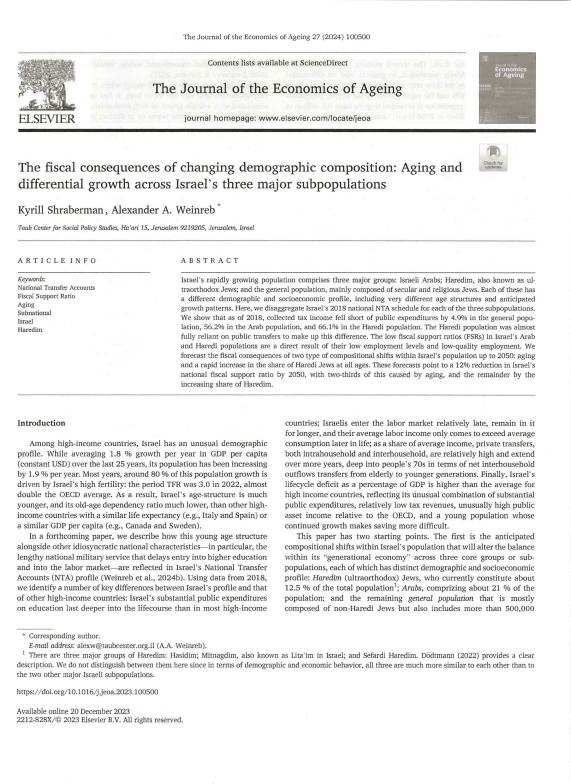The fiscal consequences of changing demographic composition : Aging and differential growth across Israel's three major subpopulations

Contenido multimedia no disponible por derechos de autor o por acceso restringido. Contacte con la institución para más información.
| Tag | 1 | 2 | Value |
|---|---|---|---|
| LDR | 00000cab a2200000 4500 | ||
| 001 | MAP20240009540 | ||
| 003 | MAP | ||
| 005 | 20240607130749.0 | ||
| 008 | 240607e20240205gbr|||p |0|||b|eng d | ||
| 040 | $aMAP$bspa$dMAP | ||
| 084 | $a921 | ||
| 100 | 1 | $0MAPA20240019334$aShraberman, Kyrill | |
| 245 | 1 | 0 | $aThe fiscal consequences of changing demographic composition$b: Aging and differential growth across Israel's three major subpopulations$cKyrill Shraberman and Alexander A. Weinreb |
| 300 | $a13 p. | ||
| 520 | $aIsrael's rapidly growing population comprises three major groups: Israeli Arabs; Haredim, also known as ultraorthodox Jews; and the general population, mainly composed of secular and religious Jews. Each of these has a different demographic and socioeconomic profile, including very different age structures and anticipated growth patterns. Here, we disaggregate Israel's 2018 national NTA schedule for each of the three subpopulations. We show that as of 2018, collected tax income fell short of public expenditures by 4.9% in the general population, 56.2% in the Arab population, and 66.1% in the Haredi population. The Haredi population was almost fully reliant on public transfers to make up this difference | ||
| 650 | 4 | $0MAPA20080625597$aEnvejecimiento de la población | |
| 650 | 4 | $0MAPA20080553883$aDemografía | |
| 650 | 4 | $0MAPA20080554385$aFiscalidad | |
| 650 | 4 | $0MAPA20080597207$aIngresos financieros | |
| 651 | 1 | $0MAPA20080656478$aIsrael | |
| 700 | 1 | $0MAPA20240019341$aWeinreb, Alexander A. | |
| 773 | 0 | $wMAP20210010194$g05/02/2024 Volumen 27 - 2024 , 13 p.$tThe Journal of the economics of ageing $dOxford : Elsevier ScienceDirect, 2021- | |
| 856 | $uhttps://www.sciencedirect.com/science/article/abs/pii/S2212828X23000609 |

